
Grow North – Guest Artist
Welcome to the North York Arts Guest Artist Program, previously known as the Grow North Creative Residency.
The Guest Artist Program is a two-month opportunity designed for individual artists or arts collectives to develop their work while engaging with the North York community. Think of it as a small-scale residency with a big community impact!
As a Guest Artist, participants have access to our space to support their creative process, along with the opportunity to share their practice through North York Arts’ platforms. We’re handing them the mic—inviting them to showcase their work and voice through our social media channels.
This program is all about amplifying local artistic voices and creating space for connection, storytelling, and community celebration.
We are excited to introduce our Spring 2025 Guest Artist, Imran Jatoi!![]()
Stay tuned for more from Imran over the next two months.
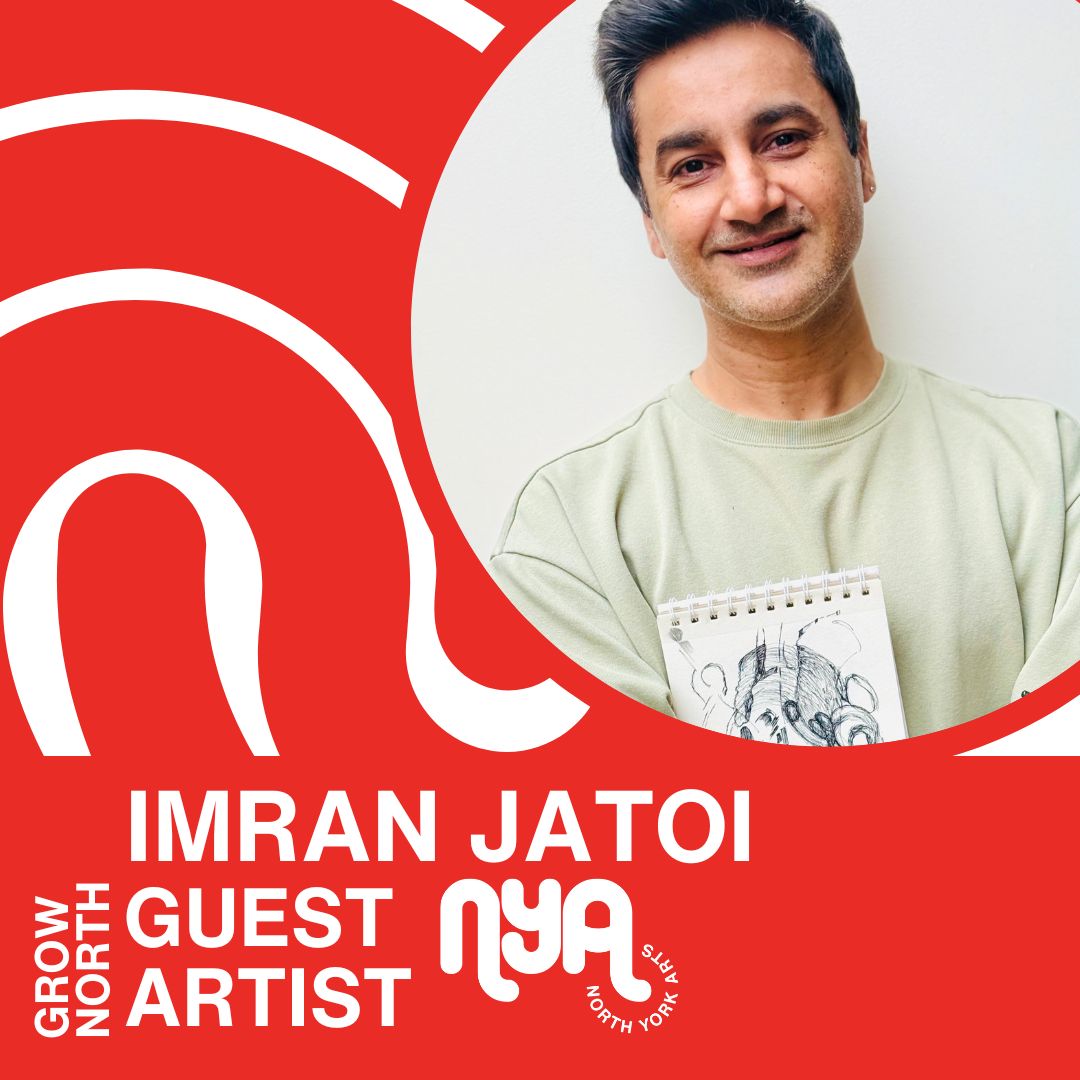
Imran Jatoi – Spring 2025
NYA is thrilled to announce that our Spring 2025 Guest Artist is Imran Jatoi! Over the next two months, Imran will be curating a dynamic series of social media and blog posts.
Get to know Imran:
“I am a queer South Asian of Pakistani origin, a practising visual artist, expressive arts therapist, and educationist. I immigrated to Canada under the Arts and Culture self-employed classification. I hold a bachelor’s degree in Fine Arts and a postgraduate degree in Art and Design from Turkey. My creative practice is rooted in the exploration of queer ideologies of identity—particularly gender and sexuality, orientation, faith, and autobiographical allusions—through multidisciplinary approaches. I enjoy creating artworks driven by a passion for raising awareness for visible minorities.”
"Whispers and Shouts on Paper"
life on paper. When I first touch graphite or charcoal to the page, I’m not just drawing, I’m
starting a conversation with myself. Each stroke feels like an honest question, probing corners
of my heart I didn’t even know were there. Sometimes the line feels strong and certain, as
though I’ve found solid ground. Other times it wobbles and drifts, reminding me of days when I
feel lost or unsure. But every mark, whether bold or gentle, reminds me that I am present and
real. Drawing isn’t about perfection; it’s about being true to what’s inside.
wonder, while a thick, dark slash can roar with confidence or defiance. I let my hand dance
between these extremes on purpose. The gentle curves explore small joys or quiet fears. The
fierce strokes claim space—for my art, for my identity, for my right to be seen. Those shifting
rhythms on the page mirror how I feel inside: peaceful one moment, restless the next. By giving
myself permission to draw both tender and wild lines, I remind myself that who I am never stays
the same. I am always growing, reshaping, unfolding.
draw figures mixed with petals, but there they are, tangled forms that pulse with something
familiar. I recognize the twisting vines as the part of me that blends strength and softness. I see
bodies drawn with curves that suggest a lover’s touch, hinting at longing without spelling it out.
Those intimate marks carry electricity, inviting anyone who looks to fill in the unseen parts with
their own desires. In those moments, drawing feels like sharing a secret,my body, my pleasure,
my story, without saying a single word.
in a storm, and the only way to calm them is to repeat lines over and over, building layers until
shapes tremble with energy. This rhythm of repetition becomes a silent meditation; my hand
finds its own beat, and my mind slows down. Then inspiration can strike like lightning, and I race
to capture it with quick, urgent strokes. I draw, then smudge, then scrape away, then sketch over
it again, as if I’m alchemizing my own identity. This cycle of making, unmaking, and remaking
feels like freedom. Each time I rework or layer over a mark, I remind myself that change is not
failure, it’s the truest form of creation.
stories and emotions. Every new drawing is a fragment of my autobiography, traced in charcoal,
ink, and pastel. Through my art, I’ve found an anchor when the world tries to push me into
corners labeled “masculine” or “feminine,” “strong” or “delicate.” I’ve discovered that identity isn’t
a straight path but a winding journey through uncharted territory. And perhaps the most radical
act of all is simply showing up, day after day, paper after paper, with nothing but a pencil and a
willingness to be vulnerable. My lines don’t have to be perfect; they only have to be honest.
don’t need fancy supplies or formal training. All you need is a pencil, or even your finger on a
foggy window, just enough to trace a line. Let that line lead you somewhere new. Notice how it
curves or breaks, how it whispers or shouts. You might find hidden parts of yourself you never
knew existed. You might feel a warm rebellion stirring in your chest. You might simply feel a
moment of peace in the act of creation. Every mark you make is an invitation to explore, to
question, and to celebrate your own story. And in every quiver of that line, you might just
discover the most honest version of you.
Stay connected with Imran’s journey!
IG: @imranfaizjatoi
LinkedIn: Imran Jatoi
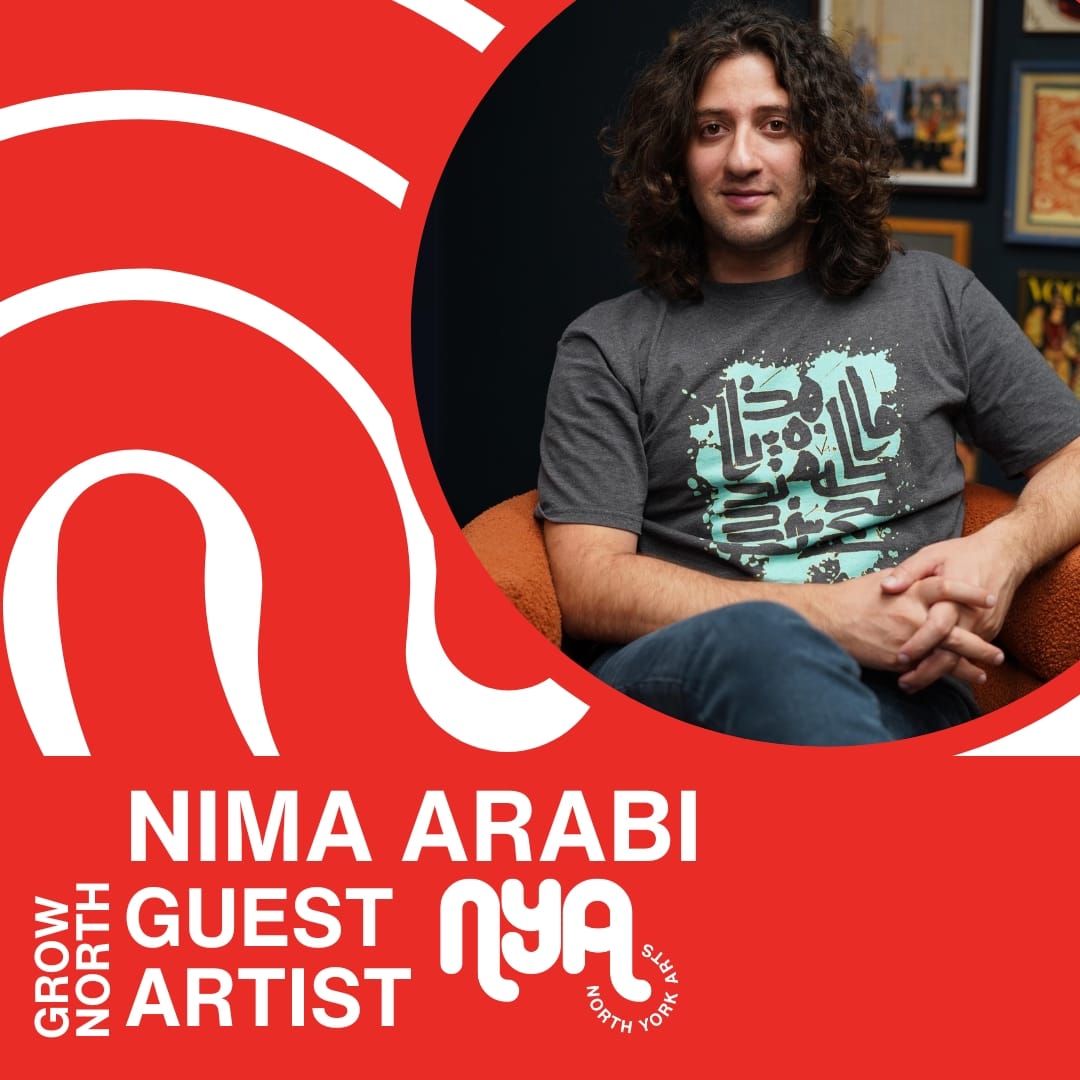
Nima Arabi – Fall/Winter 2024
NYA is thrilled to announce that our Fall/Winter 2024 Guest Artist is Nima Arabi. Nima will be curating a series of social media and blog posts over the next two months.
Nima is a Toronto-based visual artist working primarily with drawing and sculpture, focusing on themes of personal and cultural identity. His work is deeply influenced by Persian mystical poetry, particularly the concepts of the external (zahir) and the internal (batin), and how these ideas shape human experiences. Through his practice, he explore the oneness of being, creating installations that unite the artist, viewer, and space.
His work involves both traditional expressive drawings and three-dimensional sculptures made from industrial materials like packaging cardboard and flooring paper, which he repurpose to reimagine their function. He holds a Master’s degree in Fine Arts from York University and have exhibited solo in Canada and Iran. His work has also been featured in group exhibitions at the AGYU and Varley Art Gallery. Alongside his studio practice, he teaches art courses, fostering community engagement through education.
GET TO KNOW NIMA Q&A
We asked Nima a few questions to give you a glimpse into the creative mind behind her practice. Get to know the inspiration and vision that fuels her artistry!
focused on quickly completing each piece, eager to move on to the next. My art practice,
however, taught me to value the journey as much as the destination. Now, I approach my work
with multiple sittings, allowing ideas to unfold and spending time testing my materials. I’ve
found that the more I invest in understanding the medium and refining the approach, the richer
the final piece becomes. This patience has extended into my life, teaching me to appreciate
processes and to take things step by step. It has made me a calmer, more grounded person, both
in art and in life.
This project is an opportunity to explore the intersection of two-dimensional and three-
dimensional forms, creating works that balance line and physical structure. During this time, I’ll
be sketching, researching, and documenting my ideas, building a foundational vision for this
series. My goal is to compile this creative exploration into a grant proposal to help realize the
project on a larger scale. This time with North York Arts gives me the space to experiment and
develop a solid framework to bring this concept to life.
community, I feel seen and validated as a professional artist. It’s not just about exposure; it’s
about belonging to a network that supports and encourages my growth. This recognition has
boosted my confidence, allowing me to refine my voice and approach, knowing that it resonates
with an audience. It’s empowering to feel that my art has a home and community here.
Behind the Canvas: A Deep Dive into My Drawing Process
Behind the Canvas: A Deep Dive into My Drawing Process
Art is as much about the journey as it is about the outcome. For me, drawing is a profoundly meditative and transformative practice that intertwines intuition, philosophy, and self-expression. Every step, from the initial preparation to the final line, carries meaning and reflects my identity as an artist. This blog offers an inside look into my creative process, the tools I love, and how each drawing comes to life.
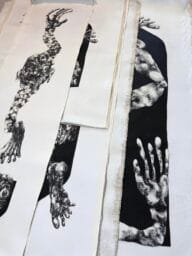
Why Share My Process?
As a multidisciplinary artist, I believe in the power of storytelling through art. Sharing the process behind my drawings allows me to connect with others on a deeper level, offering insight into how ideas transform into tangible pieces of work. My journey is intuitive, reflective, and, at times, unpredictable. By sharing it, I hope to inspire others to see art not just as a product but as a journey of discovery and personal growth.
Preparing for a Drawing: Where Intuition Meets Intention
Every drawing starts with a spark of inspiration. For me, these moments are intuitive, often fleeting, yet deeply impactful. I ask myself how I can expand on or transform these initial ideas into something meaningful. This brainstorming phase involves balancing my skills, the chosen medium, and my vision for the final piece.
When I decide to work on canvas, I imagine the composition and mood of the piece. This mental sketching helps me determine the canvas size. Cutting and preparing the canvas is a ritual in itself, one that sets the tone for the rest of the process. It’s a deliberate act of readiness—a promise to honor the blank canvas with something worthwhile.
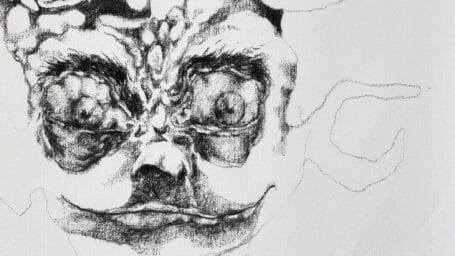
Charcoal: My Tool of Transformation
Charcoal is my medium of choice, and my relationship with it is a deeply personal one. I love its raw, transformative quality and the rich contrast it offers. Using charcoal feels like working with a piece of nature, refined through pressure and time.
The process of cutting my own charcoal sticks is an intentional act. It grounds me, reminding me of the material’s organic origins and the history it carries as one of the oldest artistic tools. Charcoal’s unerasable marks challenge me to be thoughtful with every stroke, turning each line into a deliberate decision.
This material is also meditative—the sound it makes against the canvas is soothing, and the process of working with it feels like a dance between creation and reflection.
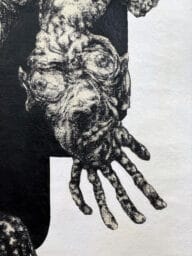
The Steps of Creation
The first line is always the hardest. It carries the weight of possibility and sets the tone for the entire piece. This line is like a guide—a trusted starting point for a journey into the unknown. Before making it, I think about the beauty of the blank canvas and ask myself if my work will be worthy of replacing its pristine state.
As the drawing progresses, I surrender myself to the process. Lines build upon lines, shades deepen, and contrasts emerge. The act of drawing becomes a meditation, where my thoughts flow freely and time seems to dissolve. It’s a deeply immersive experience, one that connects me to the work on both a physical and emotional level.
When the background begins to take shape, the piece starts to tell its story. I step back often, analyzing the composition and letting the work itself guide me toward completion.
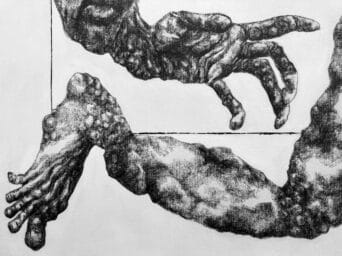
Knowing When It’s Done
Deciding when a piece is finished is as challenging as drawing the first line. It’s an intuitive process, one that requires distance and reflection. I often step away for hours or even days, allowing myself to see the work from fresh perspectives.
Over time, the drawing begins to speak back, signaling whether it needs more attention or if it has reached its final form. This dialogue between the artist and the work is one of the most rewarding aspects of the creative process.
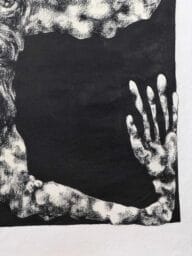
A Reflection of Identity
My art is a reflection of my identity and philosophy. It’s rooted in curiosity and a desire to question the familiar. By distorting human forms and faces, I create work that feels both recognizable and alien—pieces that provoke thought and invite viewers to engage with their own emotions and assumptions.
Drawing is also a practice in patience, a quality I continually cultivate through my work. The meditative nature of the process helps me find clarity and balance, both on the canvas and in life.
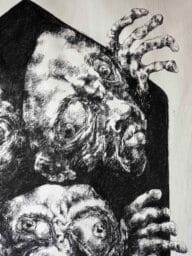
The Evolution of Process
Over the years, my process has evolved as I’ve explored new materials, techniques, and ideas. I embrace the act of deconstruction and reconstruction, using it as a tool for growth and discovery. This philosophy of questioning and reimagining extends beyond my art—it’s a way of engaging with the world and finding meaning in every experience.
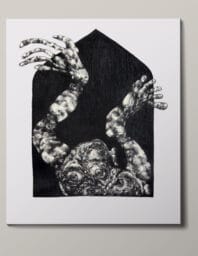
Closing Thoughts
For me, drawing is more than a skill—it’s a way of being. It’s a journey of self-expression, reflection, and connection. Through my art, I hope to inspire curiosity and spark dialogue, encouraging others to see the world and themselves in new ways.
What inspires your creative process? How do you connect with the act of creation? I’d love to hear your thoughts—let’s continue this conversation together.
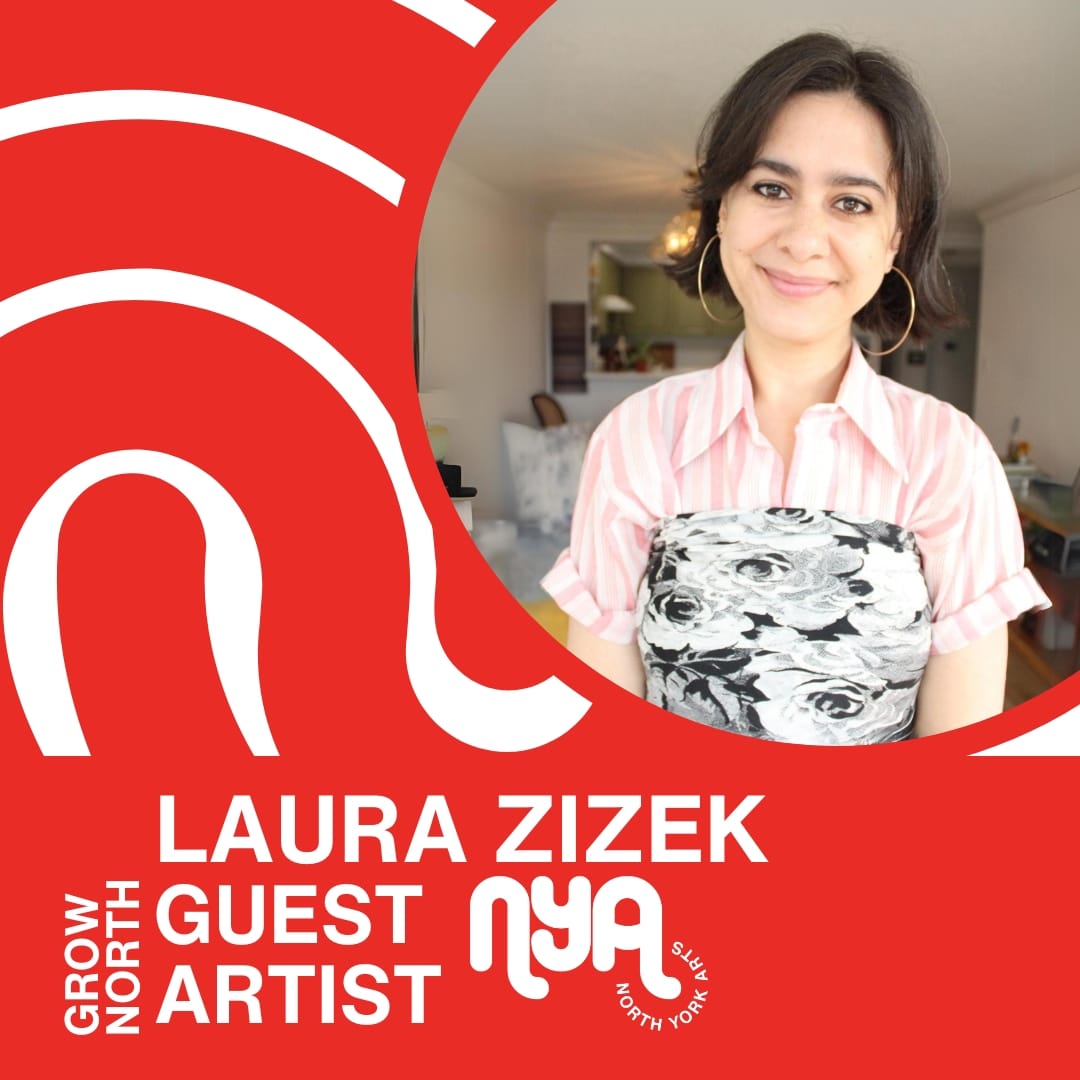
Laura Zizek – Summer/Fall 2024
NYA is thrilled to announce that our Summer/Fall 2024 Guest Artist is Laura Zizek. Laura will be curating a series of social media and blog posts over the next two months.
Laura has always been a creative person, whether it’s with embroidery, trying to make clothes, painting, etc., different creative practices have captured her attention throughout the years but since she started making stop motion animations she hasn’t wanted to stop. When her life gets too busy, and she hasn’t made space to make a new stop motion video she misses it.
The first stop motion video she ever made was in 2010, it was my summer break, and she was bored. So, she went into the backyard, found some white rocks and spelled out the word ‘hello’ and then they transformed into a squiggly line. From then on, she slowly started playing around with stop motion animations. She would animate the books she read the previous month, and each month she would find new ways to show what she read, and she made these regularly for years.
GET TO KNOW LAURA Q&A
We asked Laura a few questions to give you a glimpse into the creative mind behind her practice. Get to know the inspiration and vision that fuels her artistry!
My Process for Creating a Stop Motion Animation
I thought I would share with you my process for making one of my stop motion videos, particularly the first social media post I made for North York Arts.
I knew I wanted it to be an introductory post about me so what better way to illustrate that than to make mini paper versions of myself.
My original idea had paper-me floating down, holding balloons that spell out my name. Once I land, a big hand comes out of one corner of the screen, waves, and then drops down a bunch of my favourite things (books, camera, a pencil, etc.). This scares paper-me but once I see that it means no harm I burst
out laughing.
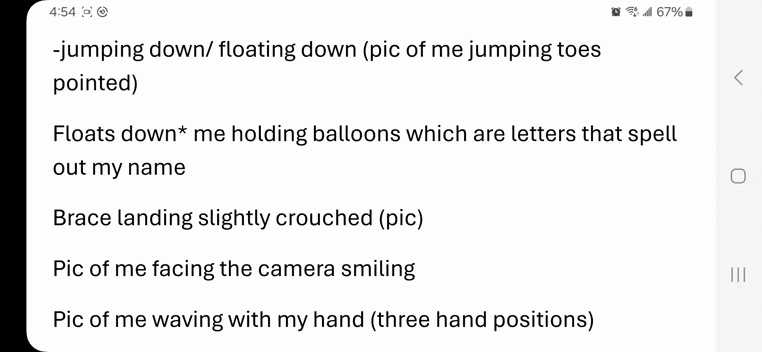
I then type up my storyboard/ shot list. Take a bunch of pictures of myself in every pose. I go through and select the photos I’m going to use and add them to a word doc, alter the sizes of the photos and then print them out.
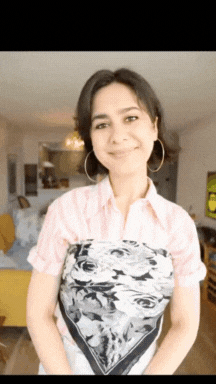
I do not have a colour printer, so I go over to my aunt and uncles house to print all my images and what I imagined was going to be a quick step ends up taking awhile because the images were coming out streaky and faded. My uncle fixes the printer but is very insistent that I don’t throw away the streaky images and maybe I could use them in the animation. I humour him but what I’m really thinking is I’ll use them as scrap paper. But then I think of the glitch segment, and my idea starts to change a bit and I turn some paper-me’s into glitching versions of me. I cut out all the pieces, I lay them in a book with some weights on top, so the paper doesn’t curl and I leave it in there for a couple of days.
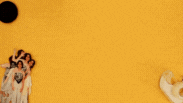
Then on filming day I take out all my paper props and start figuring out my background. I originally wanted a giant crescent moon to hang from one side (I thought it would look cool and give it a vintage-y movie set look). So, I film it this way but the sizing looks off, so I scrap it.
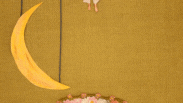
In the second round of filming and editing I don’t like the moment the big hand comes in and drops off all the things I like around me. To me it looks too messy and it takes too long for all the items to settle into place.
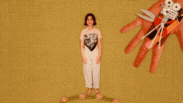
So, I scrap what I shot again, and at this moment I don’t feel great, I never love having to reshoot something, because I always feel like I should be able to get it right the first time. But after shooting and editing each time I do get a bit closer to what I want it to look like.
I take a 10-minute break, try to gather my confidence, sit back down, and start again. This time I have my items come in from each side of the screen, I work in reverse which is much easier because then I can take my time laying it all out. I add in the scrunched up blue paper balls to add in more colour and fill up the space. I also add in my disembodied head popping in to say ‘hello’ and since I like that look, in the opposite corner I add in a tiny, disembodied hand waving. Then I do a rough edit to see if I like it or if I’ll need to reshoot it for a fourth time, but finally I am pleased with it.
Then all that’s left is to find the right audio, which is me going through my mini library of sounds I have created over the years and pulling in anything that piques my interest. I watch them with the visuals to see what works. The audio that I match with the glitch is just me scrunching up some paper but if you stretch it out it turns into this very electronic tinny sound which I thought worked perfectly with the
visuals of the glitch. I also reversed the audio clip to make it sound off. I love reversing an audio clip, because it makes me feel like a professional audio engineer, I doubt they do this, but I allow myself this one fantasy.
And that was my process for my stop motion animation I made for North York Arts. If you have any other questions, you can always DM me on Instagram @laura_kz
Experience the complete stop-motion animation below:
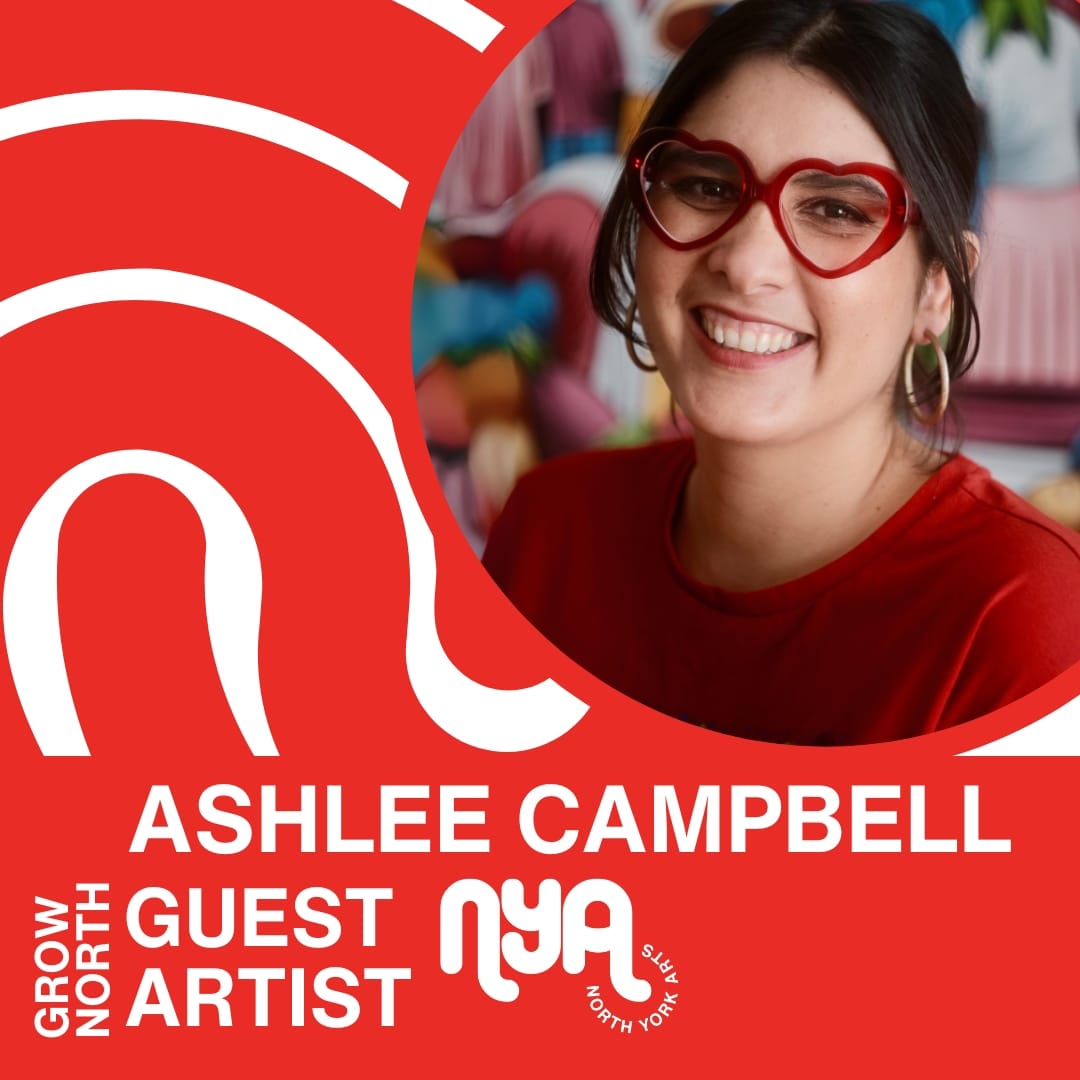
Ashlee Campbell – Summer/Fall 2024
NYA is thrilled to announce that our Summer/Fall 2024 Guest Artist is Ashlee Campbell. Ashlee will be curating a series of social media and blog posts over the next two months.
Ashlee Campbell is a poet and writer who spends most of her time cooking for people. A mother and foster parent of four kids aged four to sixteen, Ashlee is raising her boisterous crowd with her husband in Toronto — a city she didn’t grow up in but has adopted as her heart-home. Ashlee grew up across the globe, born to a Peruvian mama and Canadian dad in Niamey, Niger. She’s also lived in Haiti, El Salvador, Honduras, Mali, Chad, Malawi, South Africa, Germany and Canada, so far!
GET TO KNOW ASHLEE Q&A
We asked Ashlee a few questions to give you a glimpse into the creative mind behind her practice. Get to know the inspiration and vision that fuels her artistry!
Question 2: What projects will you be focusing on during your time as a guest artist with North York Arts?
I will be working on completing the manuscript for the sequel to my children’s book, Señora Sanasana. The working title is Señora Sanasana and The Cure for a Homesick Heart and I’m very excited for what my co-author and I have drafted so far. I’ll also spend time going over my poetry collections and editing and submitting several to poetry magazines and competitions. And I’ll be doing some author “housekeeping” tasks as well, like updating my website, writing grant proposals and preparing content for author visits.
Question 1: What is one of the most valuable lessons you’ve learned through your art practice?
One of the most valuable lessons I’ve learned through my art practice is to celebrate every milestone, no matter how small. There are so many amazing artists out there and unfortunately talent doesn’t always translate to critical or commercial success. So while it’s lovely to receive awards, accolades and paychecks, they may be few and far between. As an artist you have to develop your own ways of celebrating and recognizing the steps you take towards creating things you are proud of and add beauty and value to the world.
Question 3: In what ways has North York influenced your art practice?
I moved to North York five years ago and had the great privilege of moving to a street with wonderful neighbours, where people learn each other’s names and help each other out. I’ve always loved meeting people and creating communities, in fact my other job, besides being an author, is all about doing that. Community care in action is one of the themes of my kid’s book.
Question 4: Describe your creative process in three words.
Something I learned along the way
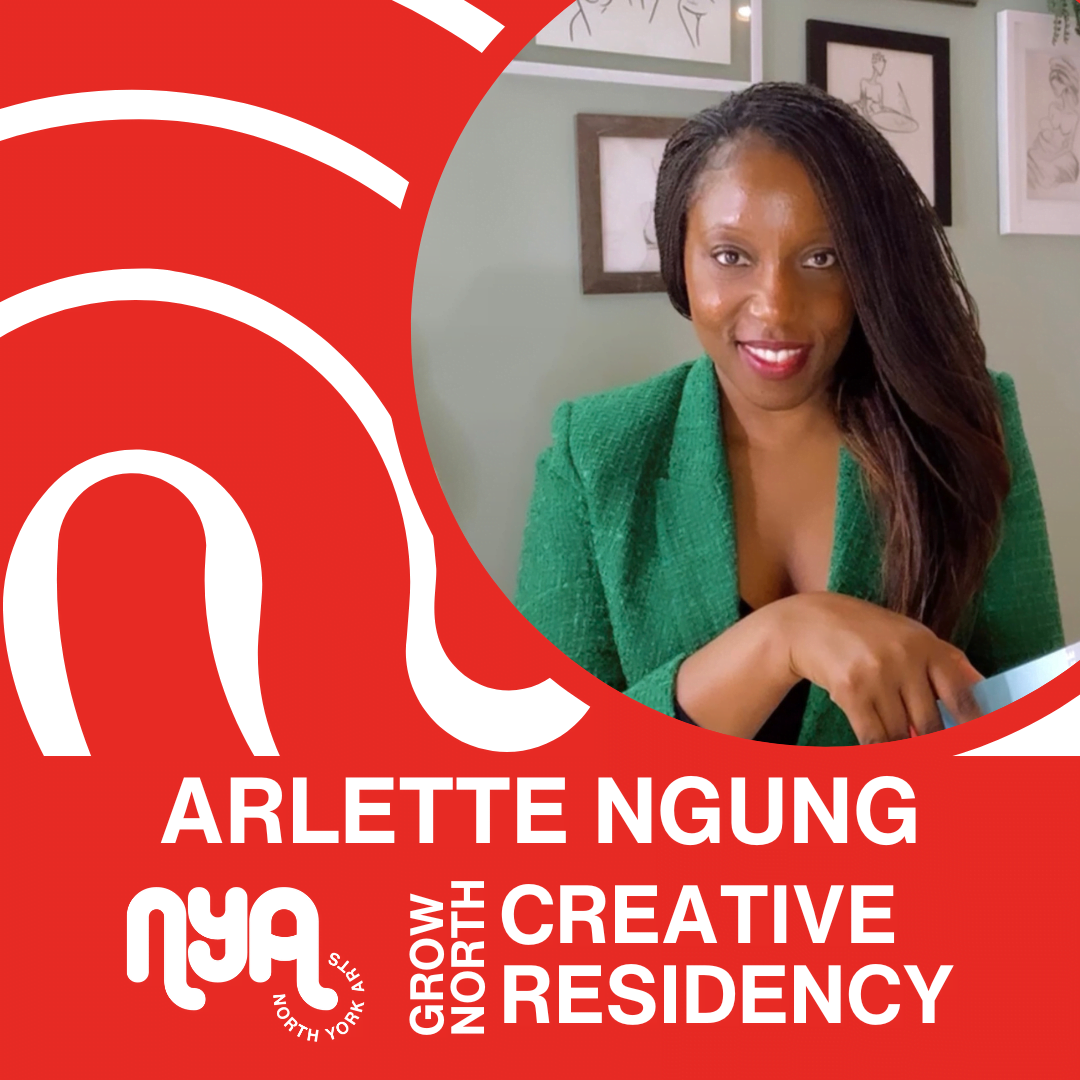
Arlette Ngung – Spring/Summer 2023
NYA is pleased to share that our Spring/Summer 2023 Creative Resident is Arlette Ngung. Stay tuned for her series of social media and blog posts over the next two months.
Arlette Ngung is a textile artist/pattern maker inspired by tradition and sustainability. Her credentials include a degree in Fashion Design/Patternmaking from the Fashion Institute of Technology of New York, USA and a Certificate in CAD from Formamod, Paris, FRANCE.
Arlette’s focus is devoted to the preservation and reinterpretation of traditional African Textile. She was profiled in interviews with CBC Radio Canada and Selvedge Magazine UK for her vegan approach to art.

Anna Kavehmehr – Fall/Winter 2022
NYA is pleased to share that our Fall/Winter 2022 Creative Resident is Anna Kavehmehr. Stay tuned for her series of social media and blog posts over the next two months.
Anna Kavehmehr is an Iranian-Canadian Illustrator with a master’s in digital media and a bachelor’s in graphic design.
Her art is largely based on internal conflicts, poems, music and literature. Telling stories through art has been her lifelong passion. She is constantly inspired by people, their struggles and relationships with one another, with nature and society.
In recent years, Anna’s work has been exhibited in Tehran, Kuala Lumpur and Toronto.
Mahsa (Jina) Amini and the Origin of the Woman, Life Freedom
I am very grateful to North York Arts for giving me this opportunity to bring awareness to what is happening in Iran and the Woman, Life, Freedom movement.
By now you have probably heard the name, Mahsa (Jina) Amini, how she became a symbol of a freedom movement in Iran, and the protests that have been ongoing since her brutal death 3 days after being in custody of the Islamic Republic of Iran’s “morality police”. You might have also heard the various chants from videos on social media or from the protests in your city.
Iranians in diaspora have made it their mission to amplify the voices of the protesters in Iran on as many platforms as we can. Since the start of the protests, the government has limited access to the internet to avoid videos or news of the protests coming out. Despite the government’s efforts, Iranians have found different ways to connect to the internet and have risked their lives to get information, photos, and videos out and get the world’s attention. Most Iranians in diaspora are getting messages from their friends and family members which is a simple ask and it is: “Don’t forget about us.” “Please continue to let the world know what is happening in Iran” Or in short: “BE OUR VOICE”.
If you have an Iranian friend or colleague, you probably are seeing them posting news and information about Iran, attend rallies, sign petitions, and ask non-Iranians to stand in solidarity with the protesters in their fight for freedom. It is because of how loud Iranians have been on social media, that we started getting media attention from major news outlets, artists, musicians, celebrities, brands, politicians, human rights organizations, and activists all over the world.
One of the most popular slogans you might have heard everyone repeating to show their support is “Woman, Life, Freedom” which has now become the battle cry of the whole movement. It is very important to highlight the history behind the slogan, its Kurdish origins, and how it mirrors protesters demands for freedom.
For context, it is important to note that Mahsa (Jina) Amini was a Kurdish Iranian woman. Kurdish people in Iran are an oppressed minority. The Kurdish slogan, Jin Jîyan Azadî (ژن، ژیان، ئازادی) was first chanted at Mahsa (Jina) Amini’s funeral in Kurdistan. The videos of her funeral went viral, and the slogan quickly became popular in both Kurdish and the Farsi translation Zan, Zendegi, Azadi (زن، زندگی. آزادی) all over Iran. The slogan encompasses everything the protesters want in 3 simple words.
Jin, Zan or Woman:
The protest was started by young Iranian women. Women in Iran have had their rights taken away and every aspect of their lives controlled by the government for the past 43 years. By starting the slogan with “Woman”, Iranians are demanding equal rights for women.
Jîyan, Zendegi or Life:
Protesters are demanding a normal life. To live life as authentically as possible in a society that offers safety and stability to its citizens.
Azadî, Azadi or Freedom:
Protesters are demanding freedom of choice in how they dress, the freedom to consume the art and media they choose, freedom to live their lives or practice the religion of their choice, freedom of expression, and in short to live as freely as possible in a society under democratic law.
Kurdish Origin of the Slogan:
Jin, Jîyan, Azadî (ژن، ژیان، ئازادی) is a popular political Kurdish slogan, which originated in Kurdish resistance movement, specifically with the Kurdish women’s movement within it. The Kurdish resistance movement was founded in response to the oppression and persecution of Kurds across the divided land of Kurdistan; in Iran, Iraq, Turkey and Syria. The slogan was popularized further and by the Kurdish leader, Abdullah Öcalan in his anti-capitalist and anti-patriarchal writings and ideologies.
The slogan marked the political activities of Kurdish women in the 2000 and was considered attractive because of its spelling, rhythm and connotational significance. It was also used among Kurdish men and women in their war against ISIS.
Woman, Life, Freedom movement is now known around the world as the first female-led revolution in the world that has demonstrated the bravery of the youth of Iran, especially the young Iranian women, fighting for their basic human rights.
Here’s some simple ways that you can show your support to the people of Iran:
Amplify Iranian voices by sharing the news about Iran on your social media platforms
Use our hashtags on your social posts: #MahsaAmini #OpIran #FreeIran #WomanLifeFreedom #مهسا_امینی #ژن_ژیان_ئازادی #زن_زندگی_آزادی
Write to your representatives and demand they take meaningful action to support protesters in Iran.
Attend a protest near you
Art is a great tool to raise awareness. If you are an artist or are simply inspired by the movement, create art, design posters, write poems, create videos and animations, or simply use your voice to create positive change.
The Significance of Protest Art in Iran
If you are on social media or have attended protests in person, you might have seen the amount of art that is being produced in support of the protests in Iran. You might be wondering why creating art is so significant in the fight for a free Iran.
For context, It is important to know that Iran has a rich history of art, poetry and music that dates back thousands of years. For the past 43 years, all forms of art have been policed, censored, repressed or blocked by the Islamic Republic government. Artists living in Iran cannot freely express themselves through art or any other means. You will find a lot of symbolism, metaphors, or other clever tools artists utilize to express what is forbidden under the Islamic Republic rules and regulations. Iranian artists living outside of Iran who create political art or feely criticize the regime, risk going to prison or worse if they ever decide to go back to Iran.
In a society where freedom of choice and freedom of expression is against the rules, to freely create art and speak your mind becomes a form of protest. This is why protest art has become so important for Iranians.
Now what is protest art? Protest art or Activist art is the creative works produced by artists and activists that reflect social movements or bring awareness to a political issue. It is a traditional means of communication for citizens, as well as protesting totalitarian regimes where freedom of expression can be seen as a form of civil disobedience. Protest art comes in many forms and mediums such as: illustration, animation, video art, music, anthems, poems, performance art, installation and more.
Many Iranian artists, myself included, feel that it is our responsibility to use our voice, platform and skills to show solidarity with the protesters, help amplify their voices through art and hopefully bring positive change to the movement.
Over the past 3 months, a large number of non-Iranian artists and musicians have also joined in on creating protest art in support of the protesters which has brought worldwide attention to the protests.
If you are an artist who is inspired by the Iranians’ fight for freedom, please use your voice and skills to amplify the Iranian voices. Create portraits, videos, posters, music or any other way that feels authentic to you, to raise your voice in support of the protesters in Iran.
Iranian Protesters at Risk of Execution
Since the beginning of the protests in Iran in September 2022, more than 500 protesters have been killed and more than 10,000 protesters have been arrested. Yet the protesters are still fighting for freedom, whether on the streets all over Iran or by various acts of civil disobedience.
In an attempt to get the protests under control and inspire fear, the Islamic Republic has charged many innocent protesters with “Moharebeh” which translates to “Waging war against God”. A crime that is punishable by death in Iran.
At least 4 protesters (Mohesen Shekari (23), Majidreza Rahnavard (23), Mohammad Mehdi Karami (22) and Mohammad Hosseini (39)) have been executed after giving false confessions under extreme physical and psychological pressure. At least another 41 protesters have received death sentences and are at risk of execution.
False confessions in Iran are a widely reported phenomenon, especially amongst the political prisoners. These confessions are often used as evidence in sham trials, resulting in expedited convictions.
Physical and psychological torture, as well as threats against the prisoner and their family or loved ones are among the methods wherein these false confessions are extracted. It’s also important to note that Iran’s legal system lacks many of the protections and due process that are guaranteed in democratic countries.
Due to the limitations on the Internet in Iran and lack of freedom of speech, Iranians in diaspora have started an online campaign to raise awareness on the executions in Iran, and get the support of the international community in hopes of getting the death sentences overturned.
If you would like to join the campaign:
- Grab a pen and paper and write #StopExecutionsinIran
- Take a photo of or with the sign
- Post it. Hashtag it!
Or simply share a post or protest art and use the hashtag #StopExecutionsinIran
You might think posting on social media and hashtags don’t help in any way. For better or worse, we live in an extremely online world where trending hashtags and social media campaigns have an incredible effect in raising awareness on a topic and in turn will have news media reporting more on the said topic.
This is how Iranians in Iran and all over the world brought attention to the death of #MahsaAmini and the #WomanLifeFreedom movement, by using the hashtags to educate, shed a light on what was happening in real-time and demand attention from the international community.
By getting the hashtags trending, we got the attention of the news media, brands, politicians, celebrities and people around the world which started a larger conversation regarding policies against the Islamic Republic and limiting their power to suppress their own people.
This is what we are hoping to achieve with the #StopExecutionsinIran and we hope that you will join us in raising your voice and supporting the people who are so bravely fighting for freedom.
How You Can Support the Protesters in Iran
One of the most beautiful things I have experienced since the start of the protests in Iran, is the solidarity my non-Iranian friends have shown from the beginning of the woman, life, freedom movement. It is absolutely wonderful to witness so many people supporting, empathizing and genuinely wanting to help Iranian protesters in their fight for freedom.
I have been asked multiple times and have seen countless comments all over social media of non-Iranians asking: “How can we help?”, and so I wanted to share some of the ways that you can help below:
- Stay engaged and share the news about Iran
- Write to your representatives and ask them to support Iranian protesters
- Sign petitions in support of the Iranian protesters
- Attend protests in your area
- Help Iranians overcoming internet blackouts and filtering
At this link, you will find a comprehensive list of resources and action items, such as how to help protesters with the internet blackouts and filtering, that is updated on a regular basis.
If you would like to stay up-to-date on the Iran news, information and real-time developments, here are some accounts you can follow on Instagram:
- Middle East Matters
- From: Iran
- Persians with Purpose
- Iranian Diaspora Collective
- Diaspora for Iran
- United for Mahsa
Thank you again to North York Arts for giving me this opportunity to amplify the voices of the protesters in Iran.

Patrick Walters – Spring 2022
NYA is so excited to share that our Spring 2022 Creative Resident is Patrick Walters. Stay tuned for his series of social media and blog posts over the next two months.
Patrick Walters is a spoken word artist/public speaker and arts educator who has spent over six years professionally using poetry to place emphasis on mental wellness and deconstructing the systems which negatively affect us – a simple message, but one of paramount importance in today’s society. Through the execution of workshops and showcases, this message is passed on to the hearts and minds of his growing audience.
How to be a professional artist who creates great art
There is no singular “Correct” way to create great art or be a professional artist. Regardless of your artistic discipline, what works for one artist, may not necessarily work for the other and therefore the ideas and “advice” that I will be sharing in this column, will be subjective, based on my (6+ years of ) professional experience and prefaced with many “I” statements. HAVING SAID THAT, “I” do believe that these ideas and practices can be applied and moulded to many artistic disciplines in ways that will achieve results and success. So let’s get into it!
Habitual Creative Time vs Genuine Inspiration
I think as we begin this conversation, it is important to note that the very nature of being a “Professional” artist is somewhat antithetical to the idea of creating amazing art. How can you continuously create the best art of your life with a deadline and a budget and oftentimes confounding stipulations put on you by someone who may not necessarily understand your artwork or artistic practice? For me, this is a question I often ask myself. The conclusion I’ve come to is this; Find the balance between creating structured time in your day for intentional and consistent creative time while also nurturing and then capitalising on moments of genuine inspiration. The reality of the situation I find myself in, is that if I just sit around and do nothing until I feel a moment of genuine inspiration, I may create beautiful and masterful art over time, but I will never be able to earn a living, let alone achieve financial and career success for myself. While I often find myself raging against this harsh reality, I have also been fortunate enough to see the benefits of having structured work and creative time in my career. In addition to that, I also truly believe that my best work comes from moments of pure inspiration where I am able to set everything else aside, and become completely enveloped in the process of doing what I was put on this earth to do; my art. I would never want to lose that. So the full picture for me is to schedule enough time in my day to complete the “must-do” art (Social media engagements, Grant proposals, emails, workshops, speaking or writing engagements, commissions etc) , while still providing room for my mind to wonder and stumble into moments of genuine inspiration and creativity (creating new poetry and music).
But, how?
Is It the Habit of Creation or Creating Good Habits?
There was never a specific point in time where I thought to myself, “Boom! Now I got it all figured out”. In fact I think many professional artists will tell you that there is NEVER a point where you have it all figured out because the balance of what is required from you is always changing from month to month and year to year. Some weeks I have all the work in the world lined up and I have to set aside much more structured time for myself because “Money affi mek!” In those moments I will naturally be more focused on worldly ideas of money, deadlines and networks and be less open to a moment where the universe will speak to you in such a way that you experience a brilliant idea for an artwork or have the strong desire to create something. Trust me, that is okay! I create a schedule for all my “Must dos” and capitalise on that because I am trying to understand that I am earning money and resources, in order to have more time and money to finance my truly artistic endeavours. Some other weeks, I may find myself with more time and space to create and it is equally important to seize those moments to the fullest because I understand that these moments are fleeting and I was the 1-in-7,000,000,000 that the Universe chose to put that artwork out to the world. In these times, I will naturally find it more difficult to cross off the “must dos” and they may oftentimes feel like even more of a chore than they already can sometimes feel like for me. Trust me, that is okay!
Ideally, in my week, I will be able to balance between the two ideas and that is actually quite a large metric by which I define “Success” for myself as a professional artist. My modus operandi is this: I want to be in the habit of being able to seamlessly switch between completing my “must do” tasks and seizing on random moments of inspiration in my day to day. If I have a good idea or a beautiful line pops into my head, I WRITE IT DOWN. I cannot tell you the amount of times I have gone back into my Google doc of ideas and found UNCUT DIAMONDS in the form of an idea that I can turn into a bar, a turn of phrase, a whole poem or even an entire project. None of those would have been available if I didn’t write it down at the time, knowing that I would return to it after my “must dos” were completed. You don’t get to decide when a moment of inspiration or creation will hit you, but you can do everything in your power to take full advantage when it does and also cultivate healthy conditions for it to occur.
IN THE END
In the end, experience and discipline will be your best teachers. You cannot create great art or be a professional artist without getting into the habit of being comfortable working on deadlines, within budgets and inside stipulations of your contracted employer. However, this does not mean that you forgo moments of genuine inspiration because you need that to feel complete and to create truly stunning pieces of art. Balancing both is the ever changing mission, and it is my privilege and my responsibility to execute that mission, to the best of my ability, on a day to day basis. This column has only scratched the surface of the iceberg in terms of this topic but I would be happy to go even more in depth on examples and personal anecdotes to give more context in the future. Thank you for reading and all the best in your mission.
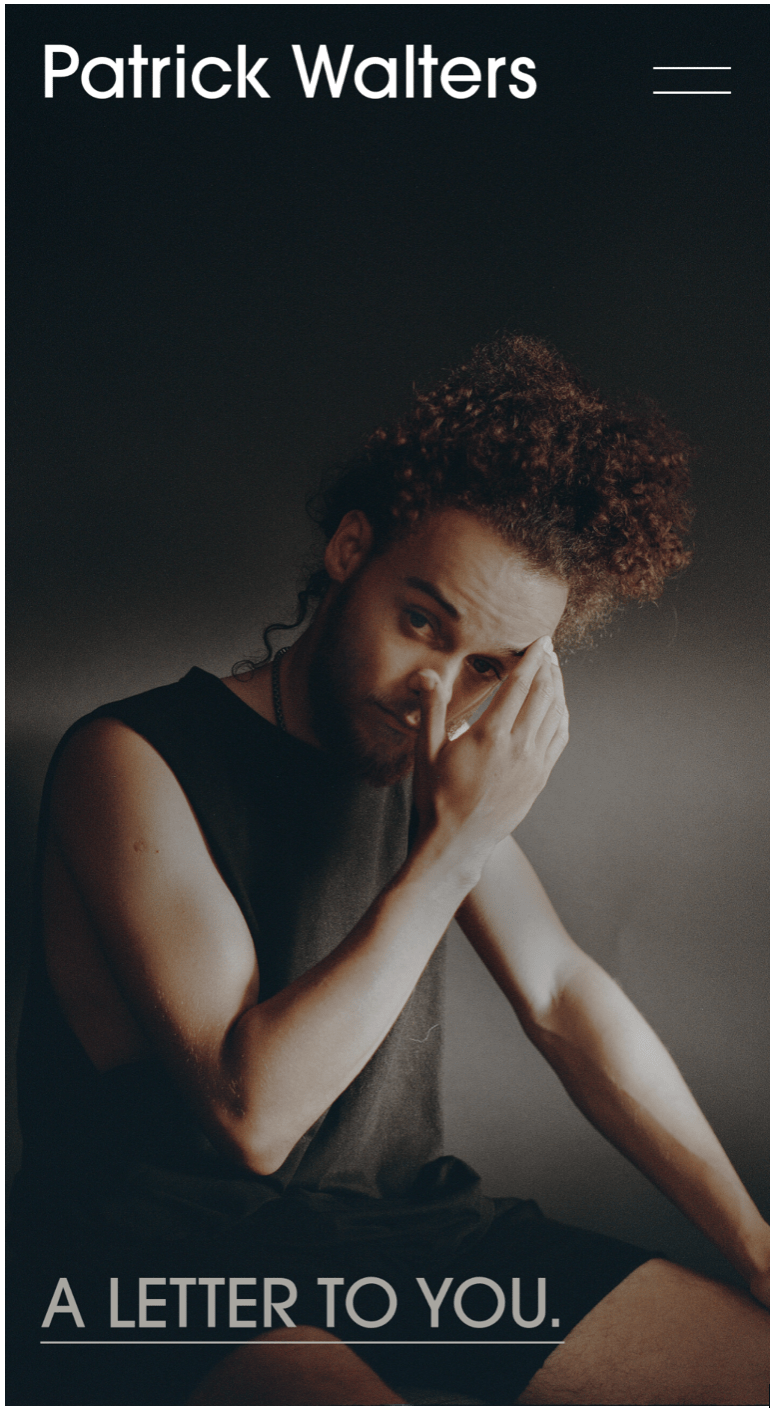

How to be a professional artist who creates great art - audio
Listen to the audio of Patrick’s blog post:
Article on independent album distribution
The art of producing and distributing an album has changed drastically in the past 20 years. Gone are the days of ‘Bad Boy’ street teams and CDs for $10 being sold out the back of a cadillac. Nowadays, almost everything about the product of music is digital and ownership of the actual music is very loosely defined. So in this new day and age, the question of how to put out an album as an independent artist is one which is both easier and more complicated at the same time. In this article, I will break down the ways in which it is both and explain to you how I have done it (twice now) for myself.
Firstly, I think there is something very important that I must discuss before I delve any deeper into this topic. That is the fact that Albums and music in general is no longer the end product of the chain of production. Up to about 2010, album sales were one of the best and most tangible ways for artists to make money. Even if you only sold a few thousand units at $10 each, that would be enough to pay everyone who helped make the album and still have a decent profit for yourself. Nowadays however, an album is merely a marketing tool, made in order to sell the actual product which is the artist themselves. Due to the advent of streaming and technology companies becoming the “middle men” between the artist and the listener, the amount that any artist can make off the purchase of an album is literally cents on the dollar. To be precise, for most streaming companies, 1 stream equals $0.005 to the artist themselves. That means that even 1,000,000 streams is a mere $5,000 to the artists who can achieve that and most artists do not average anywhere near that number of streams, even for their whole albums.
The question then becomes, ”Why make an album if there’s no direct money to be made?” The answer to this question is twofold. Firstly, if you are an independent artist, like myself, putting out an album is as simple as recording it, and signing up with one of the many distribution companies that you can pay to put your music on all streaming platforms. You don’t need to be signed to a label, you don’t need to be able to print CDs and you definitely don’t need to be super famous or super rich (although recording in studio quality can sometimes start to add up in cost). This option makes it easier than ever to put out an album and you are responsible for all your own marketing and promotion. This means that with the right information and a minimal budget, you can put your album out to the world and receive recognition that can spur your career forward and put you on the map for bigger and better opportunities down the line.
The second reason that more established artists still make albums is as I mentioned before; albums are the best promotion for the other products that major artists actually sell. Behind every major artist, is a product selling machine that is designed to be constantly churning out things for their audience to purchase, whether that be Shirts, pins, tickets to a show, commemorative memorabilia and in many high value cases exclusive access to the artists themselves. These are the things that now exist at the end of the production chain. Albums are now used to market everything else that an artist wants to sell their audience, rather than being the product itself.
As you can see there are still many good reasons to make an album, even as an independent artist. My advice to you as someone who has produced and distributed two albums so far is this;
- Find a good producer who you can work with that won’t charge you an arm and a leg for studio time.
- Follow through! Even if it takes a year or two, (My first album took two and a half years from start to finish) still follow through and put it out.
- Research the distribution company that works best for your budget and your goals. Companies like Distrokid and Tunecore are some of the ones I have used in the past and they have served me well.
Even if you are only able to put out an EP or an album with a minimum amount of songs, you won’t regret it!
If you are someone who is not an artist and merely interested in this area, I hope I have been able to feed your curiosity and show how artists put out albums. If you are an artist yourself, I hope this information serves as a guide on your way to success and also encourages you to do it!
Article on independent album distribution - audio
Listen to the audio of Patrick’s blog post:

Tasneem Dairywala – Winter 2022
NYA is thrilled to announce that our Winter 2022 Creative Resident is Tasneem Dairywala. Tasneem will be curating a series of social media and blog posts over the next two months.
Tasneem believes that art can illuminate all the nitty-gritty corners of the expected, the ordinary, and the sane. Creating art empowers her to change the unease from facing any crisis into the pleasure of unraveling it. She loves to create worlds full of magic and warmth, focusing on themes of resilience, empathy, and love.
Outside of her personal art practice, Tasneem works as the Executive Director of Art Ignite. and brings inclusive visual arts programs to the Flemingdon Park neighbourhood. Her workshops are designed to connect people from disparate backgrounds by using the arts as a tool for knowledge and understanding.
Building a Creative Practice
Building a Creative Practice
By Expecting the Unexpected
We’re all born artists, but for most of us, creativity gets buried under the pressure of heavy responsibilities, busy schedules, and rigid social structures. For those of us who are able to make room for our creativity, we still often manage to stifle it through our own expectations. So here are some dos and don’ts to build and sustain a creative practice based on my own experience!
DO
Do expect your creativity to reward you, to create an additional layer of meaning in every part of your life. A tearful hug from an audience member, a homemade cake from a participant, a balloon of happiness expanding within your heart… These are the unexpected gifts your creativity will sprinkle upon you.
DON’T
Don’t expect your creativity to reward you with money and fame. These goals are just a reflection of what society considers ‘successful’. If these are your end goals, there are easier ways to get to them. Our creations sew together the torn fragments of the world. What we create is valuable, even if it doesn’t meet the standard definition of success.
DO
Do expect your creativity to stun and surprise you. Bring down ‘art’ from its pedestal so your creativity can have free reign. Trust in the unknown. Encourage yourself. Your creativity will bloom when you play, experiment and let loose!
DON’T
Don’t expect your creativity to bring you perfection. We are imperfect beings living in an imperfect world. We can only make imperfect things. Be careful of the narrative you tell yourself. If you start creating to achieve perfection instead of joy, your creativity will go into hiding, quietly withdrawing until the pressure lifts off.
DO
Do expect your creativity to want excitement and change. Go to shows, take classes, read books. Reach out to other artists and art organisations, such as NYA! Taking the first step is scary but necessary. Seek knowledge. Build connections.
DON’T
Don’t expect creativity to always be around. Creativity doesn’t like being alone all the time, and it certainly doesn’t like being bored. Pretty much anything other than sitting at home and stewing about its absence will bring it back to you.
And that’s all I’ve got! Creativity is elusive and slippery. Expect too much, and it’ll flee. Let it breathe, and it’ll seep through the cracks of the ordinary in the most wonderful ways. I wish you the best of luck!
–
Tasneem Dairywala is an Artist, Writer and Illustrator. To read more of her writing, sign up for her newsletter at www.tasneemdairywala.com
Attending Art School
Based on: Girl, By Jamaica Kincaid
Wash your brushes immediately and put them to dry hanging upside down; Wash the acrylic ones separately and never mix them with oils; don’t leave your paintings to dry in the hot sun; they’ll cook and crack; wash your palettes as soon as you’re done using them; when buying yourself an apron, be sure that you don’t spend too much money on it, because that way you won’t feel guilty when you spill wax and paint all over; prime your canvases overnight before you paint on them; always eat your food before you start painting; don’t want toxics inside there; don’t sing while you work; don’t socialize so much; don’t eat your meals outside – you’re wasting good money; this is how to build a stretcher; this is how to stretch a canvas on the stretcher you have just built; this is how to use an easel when you’re painting something too large; this is how you smile to a professor you don’t like too much; this is how you smile to a professor you don’t like at all; this is how you smile to a professor you like too much; this is how to sculpt a pot; this is how to sculpt a face; this is how to sculpt a body; this is how you set a work on display; be sure to wash every day; the smell of your paint is better than the smell of your sweat; don’t paint too many flowers – they can make your work boring; don’t throw stones to hear the pattern of sound they make; you waste too much time daydreaming; this is how to knead red clay; this is how to knead white clay; this is how to start up a kiln; this is how to get the maximum amount of work done in the minimum amount of time; this is how to save a painting before it becomes an inconceivable mess; this is how to burn old rags; and that way your room won’t look dirtier than it is already; this is how to control your work; and this is how your grades control you; this is how to love what you do; and if this doesn’t work there are other ways, and if they don’t work, don’t feel too bad about giving up; this is how to make old supplies last; this is how to squeeze out each thumbnail for more ideas and mistakes to make sure your painting turns out looking perfect; but what if I like them imperfect?; you mean to say that after all this, you are going to be the kind of artist who thinks every mark you make is a masterpiece?
Building a Creative Career
An Interview with Tasneem Dairywala
Can you tell us a bit about yourself?
I am a visual artist and an art educator. I run a non-profit called Art Ignite and we do lots of fun art programs in Flemingdon Park. I’m also on my way to publishing my first children’s book, ‘How to Show Love’ after which, I will be able to change my status from writer to author!
What would you say are the most important parts of building a creative career?
- Continuous learning:
- By learning, I don’t mean acquiring an expensive degree or only learning about art-specific topics. Learn about whatever makes you curious, because it’s crucial to creative growth. Here are some free or low-cost education platforms that I’ve found very useful:
- Gale Institute
- TDSB classes for adults
- Coursera
- City of Toronto: Parks, Forestry and Recreation
- Toronto Public Library
- By learning, I don’t mean acquiring an expensive degree or only learning about art-specific topics. Learn about whatever makes you curious, because it’s crucial to creative growth. Here are some free or low-cost education platforms that I’ve found very useful:
- Building connections:
- Post-COVID, it would be wonderful to start attending art events again and building in-person connections. But in the meantime, there are other ways to remain connected:
- Ask every person you know if they know someone doing the same things as you. I have found this to be the absolute best way to accumulate knowledge and find collaborators.
- Join newsletters. Almost all organizations send them out, and they’re full of opportunities.
- Look at Toronto, Ontario and Canada Art Council’s websites. Search for grants related to the fields you’re interested in, look at who was funded by these grants in the past year, and reach out to them. This is how I came across NYA. They gave me the volunteer experience and mentorship needed to start my own business, and it all started with an email!
- Post-COVID, it would be wonderful to start attending art events again and building in-person connections. But in the meantime, there are other ways to remain connected:
- Being brave:
- You’ve already taken the first steps in this journey. Don’t be afraid to move forward. You’re good enough to get grants. You’re good enough to run projects. You’re good enough to do whatever you desire!
What are some of the steps you take to apply for grants?
- Attend grant writing workshops by funders.
- Include keywords from the grant description and evaluation metrics in my application.
- Talk to the grant officer before applying.
- Plan the budget before the project so I know what’s achievable.
- Make sure the support material is high quality.
- If they’re asking for reference letters, make sure the letter is signed, has a header, the correct date, and answers their questions.
- If they’re asking for art work, make sure it’s professionally documented.
- Break up long questions into smaller sections. This helps to ensure that the entire question has been answered and no details have been left out.
- Ask people to proofread. Most people want to help and will say yes!
- Start and submit the applications as early as possible to avoid getting stressed.
- Ask the grant officer for feedback if the application is unsuccessful.
- Pay someone to write the grant if the application is repeatedly unsuccessful. It’s a great learning experience and worth it, especially if the grant writer works on commission.
Are there any grants that are good for emerging artists?
- Art Reach is a great one if you’re under 30.
- Cultural Hotspot is also fantastic, but you have to partner with an organization.
- Toronto Arts Council and Ontario Arts Council applications are not too hard, but each program has a different eligibility criteria. Make sure you meet it before starting the application.
- Inspirit workshop is also great if you have a project idea specific to their mission.
- Microgrants are good starters, but they pop up randomly. Keep an eye on your newsletters!
Is there anything else you would want to tell an emerging artist?
The art world is like a buffet. You want to keep adding projects to your plate even after it’s full. But it’s not sustainable. It’s a long journey so take care of yourself and your mental health. There will always be more opportunities.
The Creative Residencies are part of our Grow North Program, an initiative proudly supported by Northcrest Developments.
